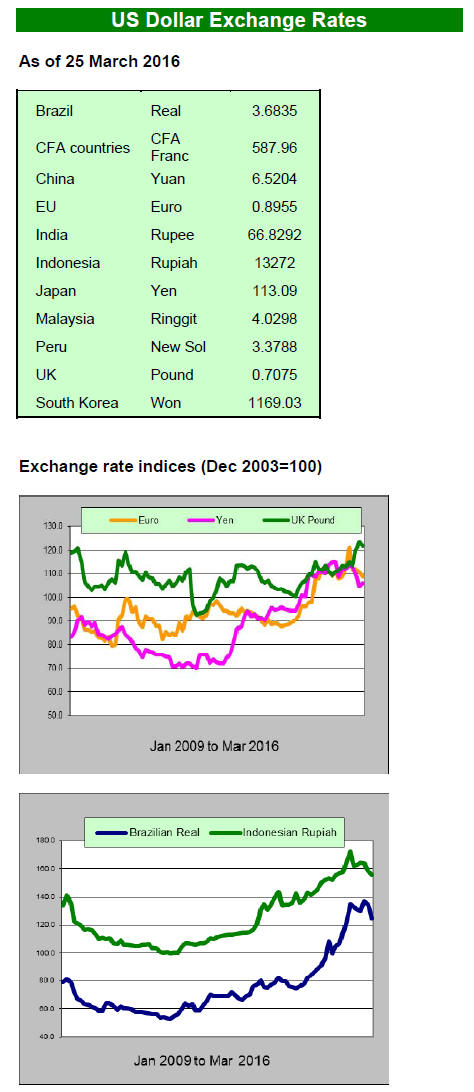2. GHANA
Joint Team Review Ghana Timber Trade
Agreement
The Government of Ghana and the European Union (EU)
recently met in Accra to review progress towards
implementation of the Voluntary Partnership Agreement
(VPA).
The Ghana-EU VPA Joint Monitoring and Review
Mechanism (JMRM), which included representatives of
stakeholder groups, was tasked to oversee implementation
of the agreement.
The JMRM reviewed the status of development of Ghana's
timber legality assurance system and also discussed
outstanding issues to be addressed in the joint action plan,
the last step before ratification of the agreement and the
start of FLEGT licensing.
Speaking to the media the Minister of Lands and Natural
Resources, Mr. Nii Osa Mills, said when the FLEGT
licenses are issued Ghana's timber products would enter
the European market without the EU importers having to
comply with the due diligence obligations of the EU
Timber Regulation.
According to the Minister, the country has made progress
in forest governance by clarifying its forest management
plans and improving transparency which has brought
Ghana closer to licensing and easier access to the EU
market. The development of the national timber legality
assurance system would also help Ghana resolve legality
issues in the domestic market.
To track progress in the national timber legality assurance
system, the JMRM decided to meet in August for the next
assessment. Ghana signed the VPA with the EU in 2009
aiming to ensure verified legal wood products are
produced for export and the domestic market.
The issue of legality is of particular importance in the
domestic market where large volumes of illegally sourced
and chainsawn timber are sold.
UNIDO training for Timber and Furniture Lab
UNIDO recently concluded a training programme for staff
at Ghana¡¯s Timber and Furniture Laboratory in the
Forestry Research Institute. The training focused on
building capacity for ISO/IEC 17025 certification. This
training programme was supported by UNIDO¡¯s ¡®Trade
Capacity Building Programme.
Mr Victor Mills, the National Project Coordinator for
UNIDO, said the training at the Forestry Research Institute
was part of a series of events for all agencies and
institutions to assist them meet international market
demands.
Forestry Research Institute of Ghana (previously named
the Forest Products Research Institute) is located at
Fumesua near Kumasi in the Ashanti Region of Ghana.
Forestry Commission needs better resources to
protect forests
Samuel Afari Dartey, Chief Executive Officer of the
Forestry Commission of Ghana, said during Forestry Day
celebrations his organization is in dire need of more
trained personnel and better logistics. He said if the
Commission is to meet the demands of government in
protecting the country¡¯s forests it need more resources.
According to the Forestry Commission in Ghana the 293
forest reserves covering an area of 2.4 million hectares and
the 23 wildlife protection areas (about 1.34 million
hectares) serve as important watersheds and in some cases
headwaters of important rivers.
Mr. Darty reported that Ghana is losing large areas of
forest to un authorised bush burning, illegal mining and
unauthorized settlements.
Mr. Dartey mentioned the adoption and implementation of
a new Forest and Wildlife Policy-2012, the national forest
plantation programme, the Voluntary Partnership
Agreement (VPA) and Forest Investment Programme
(FIP) as some initiatives that have already been launched
to reverse the trend of deforestation and land degradation.
March prices
Prices for wood products remained unchanged as of 30
January.
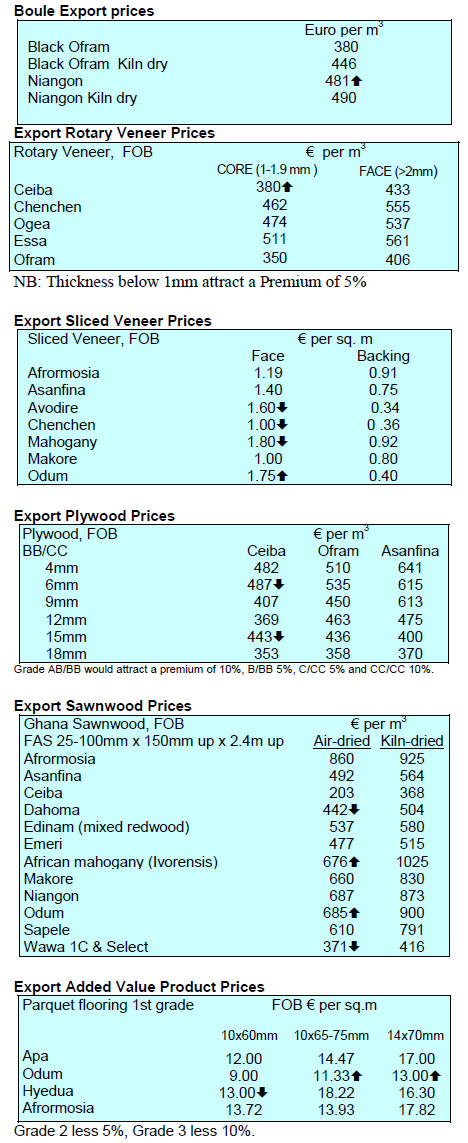
3. MALAYSIA
Regional markets to be foundation
of 2016 exports
The Malaysian Timber Council (MTC) is optimistic of
maintaining the momentum in wood product exports this
year despite global challenges.
MTC Chief Executive, Dr. Abdul Rahim Nik, revealed
that Malaysia¡¯s 2015 exports of sawnwood, plywood,
veneer and furniture increased 6.5% year on year to
around US$5.5 billion.
Furniture exports alone increased 14% last year and
overall, the timber sector provided just over 18% to total
exports earnings in the commodity sector. Rahim said the
outlook for the industry was quite positive, especially in
terms of the opportunities for sales within the region. India
is a market with huge potential as is the furniture market in
China.
To capture the opportunities in these markets Rahim said
¡°Continued growth and progress are largely dependent
upon industry¡¯s ability to shift from the current
manufacturing-based mind-set to one that is more
innovation centric, providing more value-added products
to international markets¡±.
Japan, the major market for Sarawak wood products
The value of Sarawak¡¯s 2015 timber exports fell 9% to
RM6.6 billion compared to RM7.2 billion in 2014. Export
earnings for the first two months of 2016 are also trending
lower.
The State Minister of Resource Planning and
Environment, Awang Tengah Ali Hasan, reported that
only sawnwood exports have held up with all other
products posting losses. To-date products that contributed
most to 2016 export earnings were plywood (48%), logs
(27%) and sawn timber (12%).
In the first two months of the year Japan continues to be
the major market accounting for 36 % (RM373 million) of
total wood product exports. Other markets included India
(21%), Taiwan P.o.C (9%), Middle East countries (9%),
Korea (8%), the Philippines (6%), Vietnam (3%) and
Thailand (2%).
Efforts to combat illegal logging in Sarawak have been
intensified. The Chief Minister, quoting official statistics
for the period 2009 ¨C 2014, said that the volume of illegal
logs seized was less than 1% of total log production and
that none of the main logging companies had been found
to be logging illegally.
Sarawak plywood prices
Plywood Traders in Sarawak reported the following export
prices:
Floor base FB (11.5mm) US$580/cu.m FOB
Concrete formboard panels CP (3¡¯ x 6¡¯)
US$500/cu.m FOB
Coated formboard panels UCP (3¡¯ x 6¡¯)
US$580/cu.m FOB
Standard panels
S Korea (9mm and up) US$390/cu.m FOB
Taiwan P.o.C (9mm and up) US$400/cu.m FOB
Hong Kong US$400 FOB/cu.m
Middle East US$380/cu.m FOB
4. INDONESIA
Calls for support to aid industry
upgrading
Furniture and craft enterprises have alerted government of
a looming crisis, a serious shortage of skilled technicians
for the sectors. Spokespersons from the two sectors have
urged government to offer support to companies so that
they can fully meet export targets.
The Secretary General of the Indonesia Rattan Furniture
and Craft Association (AMKRI) said expanded training
facilities and support for enterprises as they upgrade their
technologies and management are essential to ensure
growth of the industry. Last year furniture exports were
almost US$2 billion, just a fraction of the estimated
US$140 billion global furniture market.
The International Furniture Expo (IFEX) 2016 has just
concluded and this year Indonesian manufacturers secured
orders worth around US$325 million.
Rebound in exports welcomed
According to Indonesia¡¯s Central Statistics Agency (BPS),
compared to a month earlier Indonesia¡¯s February 2016
exports to Japan rose by 5.3% and exports to China
increased 6.6%.
The Head of the BPS reported that exports to Japan and
China have improved significantly with 17 of Indonesia¡¯s
24 export commodities recording an increase in February.
In addition to wood products, Indonesia¡¯s commodity
exports to the US, Japan and China included textiles,
electronics, rubber products, palm oil, footwear,
automotive products as well as fishery and agricultural
products.
Legality verification opens way to expanded exports
Speaking at IFEX 2016, Agus Justianto of the Ministry of
Environment and Forestry, said his Ministry appreciated
the commitment of the EU and other countries in
combating the trade in illegal timber. These efforts, he
said, have created new opportunities for through the
national SVLK increase exports.
In support of the statement by the Ministry spokesperson,
Maria Murliantini, a handicraft manufacturer and exporter
said her company had seen an increase in trade and in
profits since the company secured SVLK certification.
New opportunities had opened up for the company in
Germany, France, Australia, the United States and
Sweden.
Forest fires in Jambi intentional
The Governor of Jambi province in Central Sumatra has
said almost all forest fires in the province were
intentionally started as a means to clear land for
agriculture.
Fire control efforts by provincial authorities include
sending trained staff to fight fires and also calling on
volunteers to extinguish the fires. The province has banned
slash-and-burn methods used by farmers to clear land and
will cancel operating licenses for companies found guilty
of starting fires to clear land.
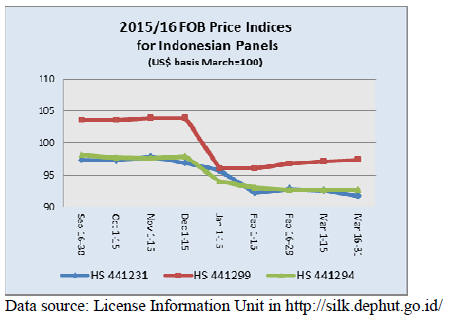
5. MYANMAR
U Ohn Win named forestry minister
The incoming administration in Myanmar has announced
the number of ministries will be cut from 36 to 21. The
Ministry of Environmental Conservation and Forests and
the Ministry of Mines are to be merged as the Ministry of
Resources and Environmental Conservation.
The former Deputy Rector of the Institute of Forestry, U
Ohn Win, has been named Minister. Private sector
spokespersons have welcomed the merging of two
ministries saying there had been times when there was a
conflict of interests between the two ministries. Win¡¯s
appointment has also been greeted by forestry personnel as
this will be the first time for decades that the ministry is
headed by someone with a forestry background.
U Ohn Win was once a professor at the University of
Forestry, Yezin. He received his Master of Science in
watershed management from Colorado State University
and has special interests in research management,
hydrology, watershed and soil conservation, climate
change adaptation and bio diversity conservation. Before
his appointment he was on the advisory board of
the Myanmar Institute for Integrated Development, a nonprofit
organisation.
MTE to get new General Manager
In a related development, analysts in Myanmar anticipate
an experienced General Manager of the Myanma Timber
Enterprise (MTE), also a Forestry graduate, will be
appointed as Managing Director of the organisation.
MTE is a state-owned institution which has sole
authority
to harvest and extract logs in Myanmar. Since 1988 the
military commanded MTE.
Appointments suggest significant policy shift
Analysts point to these appointments as indicative of a
significant in policy towards forest conservation and this
has raised concern in the timber sector. One manufacturer
said that although environmental conservation is of
importance for the country there needs to be a balanced
approach between conservation and sustainable utilisation.
The fear in the industry is that the new administration
could impose a logging ban given the high media coverage
of illegal logging, deforestation and forest degradation.
The domestic newspaper, Weekly Eleven, has reported the
out-going administration allowed the extraction of 700,000
tons of teak and hardwood logs during the 2014 financial
year. The highest recorded harvest was in 2011 when 2.3
million tons were extracted.
An article in the Voice Newspaper is advising a ban on
teak extraction as past harvests were unsustainable. The
article says more than 5 million tons of teak logs were
harvested between 1996 to 2015 while the permitted cut
for the period was only 3.38 million tons.
Data in the article illustrates that while there has been a
steady rise in harvest volumes this was accompanied by a
fall in average prices.
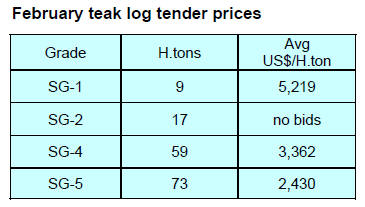
6.
INDIA
Inflation rate trends down
The Office of the Economic Adviser (OEA) to the Indian
government provides trends in the Wholesale Price Index
(WPI).
The official Wholesale Price Index for All Commodities
(Base: 2004-05 = 100) for February fell to 174.0 from
175.7 in January. The year on year annual rate of inflation,
based on monthly WPI, stood at ¨C0.91% (provisional) in
February 2016 compared to -0.90% in January.
For more see:
http://eaindustry.nic.in/cmonthly.pdf
Timber and plywood price indices climb
The OEA also reports Wholesale Price Indices for a
variety of wood products. The Wholesale Price Indices for
Wood products and Plywood are shown below.

Foreign investment in construction sector
welcomed
The construction sector is included in the list of sectors for
which the Indian government wishes to attract foreign
investment.
The Invest-India website ( http://investindia.gov.in/) has
the following to say.
¡°The Government of India is in the process of launching a
new urban development mission. This will help develop
500 cities, which include cities with a population of more
than 100,000 and some cities of religious and tourist
importance. These cities will be supported and encouraged
to harness private capital and expertise through Public
Private Partnerships (PPPs), to holster their infrastructure
and services in the next 10 years.
To provide quality urban services on a sustainable basis in
Indian cities, the need of the hour is that urban local
bodies (ULBs) enter into partnership agreements with
foreign players, either through joint ventures, private
sector partners or through other models.¡±
A data snapshot indicates that:
 US$ 1 Trillion investments for
infrastructure
US$ 1 Trillion investments for
infrastructure
sector are projected during 2012-17.
 US$ 650 Billion investments
in urban
US$ 650 Billion investments
in urban
infrastructure are estimated over next 20 years.
 100% Foreign Direct
Investment (FDI) is
100% Foreign Direct
Investment (FDI) is
permitted through the automatic route for
townships, cities.
 The construction sector contributes 8% of
the
The construction sector contributes 8% of
the
Indian GDP (at constant prices).
For more see:
http://www.makeinindia.com/sector/construction/
Plywood and particleboard losing market share to
alternatives
Rising prices for logs and process chemicals and the
continual shortage of labour are creating problems for
plywood and particleboard industries which have found
they are losing market share to MDF, HDF and WPC
(Wood Plastic Composite) boards.
Composite panels are finding wider acceptance in the
more sophisticated urban markets and are slowly eating
away at the market share held by plywood and
particleboard.
Pre-laminated particleboard and MDF panels are finding a
ready market as they are perceived as elegant and less
expensive than plywood. Plywood and particleboard
manufacturers were slow to embrace overlay lamination.
Because of this new enterprises spank up to buy raw
boards from the manufacturers and apply laminates but
this depended on finding skilled craftsmen to apply
laminates but now many such craftsmen have migrated to
Middle East and African countries attracted by higher
wages.
Today, many board manufacturers have invested in
laminating and sell ready to use panels to furniture and
flush door manufacturers. Board manufacturers without
laminating capacity now face marketing problems.
WPC boards are gaining popularity as they are strong and
water resistance and can be manufactured from a wide
range of residues. WPC boards are not only cheaper than
conventional panels but are suitable for a wide range of
enduses.
South Dangs log auction prices
Auctions in the South Dangs depots have been concluded.
Many log lots unsold from the previous auction because
buyers were unhappy at the high prices were on offer once
more.
Also on offer were some older logs so average prices
dipped. Over 10,000 cubic metres were sold. The range of
prices secured is shown below.
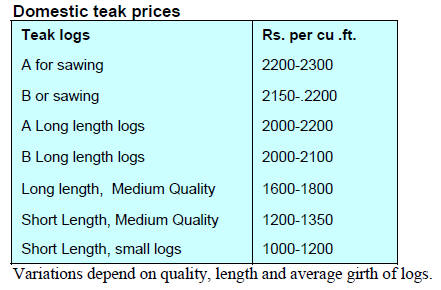
Good quality non-teak hardwood logs, 3 to 4 meters
long
having girths 91cms and up of haldu (Adina cordifolia),
Laurel (Terminalia tomentosa), kalam (Mitragyna
parviflora) and Pterocarpus marsupium logs fetched prices
in the range of Rs.600-700. Prices for medium quality logs
were in the range of Rs.350-450 per c.ft.
After a break of about six months sales were also held at
the Surat, Vyara and Rajpipla depots. Around 3,000 cubic
metres of logs were sold and prices were in the same
region as for those sold in South Dangs.
Special teak quality in Madhya Pradesh
Deliveries of teak logs to all depots of Madhya Pradesh
have been completed. Teak logs in this area are mainly in
2 to 5 metre lengths and mostly in girth class 120 cm and
below.
Logs from this area are generally straight and cylindrical
and the wood has a fine golden colour with black stripes.
The latest auctions were held at depots in Narmadanagar,
Timarni Khirakiya, and Ashapur and around 3,000 cubic
metres of teak logs were sold.
Bidders were mostly from local mills plus merchants from
Gujarat and South India. Prices realized at the recent
auction were higher than at earlier auctions.

Imported plantation teak prices
Supply and demand in India for plantation teak remains
balanced such that, except for price changes reflecting log
dimensions, the market and prices remain stable.
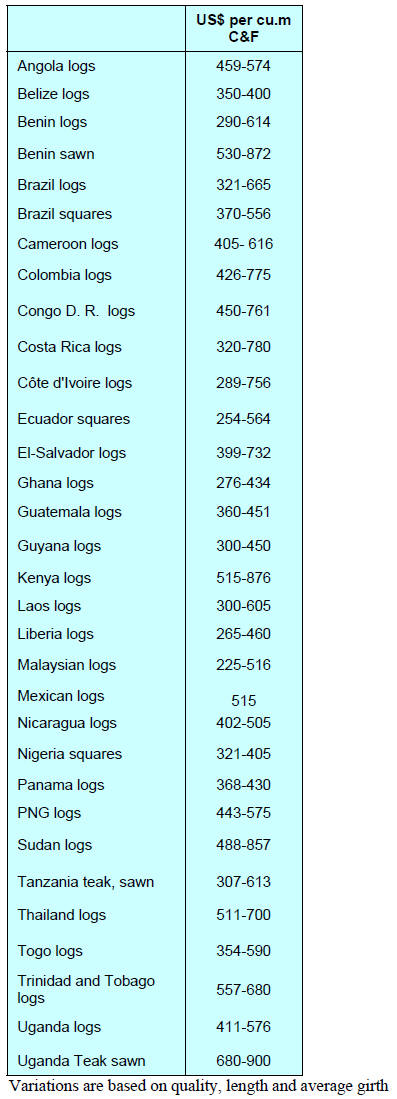
Prices for locally sawn hardwoods
As log prices rose many importers switched to importing
sawnwood which has stablised prices. But many local
sawmills which depend on imported logs are finding it
increasingly difficult to source logs at prices which allow
them to mill and compete with imported sawnwood.
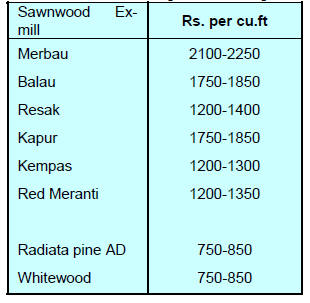
Myanmar teak flitches resawn in India
Imports of sawnwood and flitches from Myanmar are
helping maintain saleable stocks of Myanmar teak. There
has been an upwards movement in prices for some
specifications.

Prices for imported sawnwood
Prices remain unchanged from two weeks earlier.
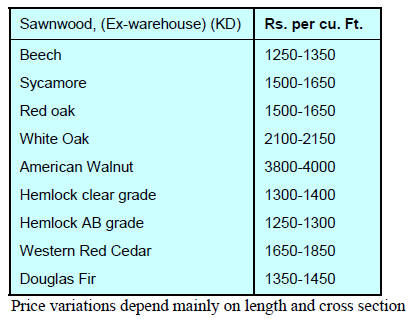
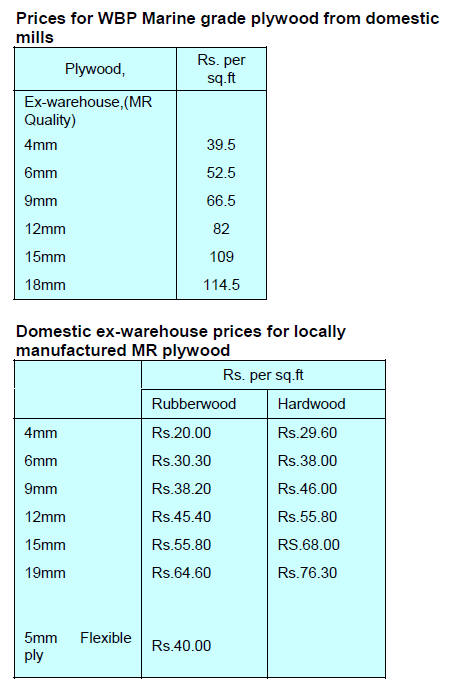
¡¡
7.
BRAZIL
Domestic economic crisis affecting timber
industry
The Wood Trade Brazil - Lignum Brazil Fair promoted by
the Brazilian Association of Mechanically-Processed
Timber Industry (ABIMCI), the Federation of Industries
of Paran¨¢ State (FIEP) and Malinovsky Events was held in
Curitiba early March. This brought together
representatives of the timber industry, log producers and
professionals involved in the wood supply chain.
During the event the state of the Brazilian economy and its
effect on the timber industry was discussed. The consensus
was that negative domestic economic growth is
diminishing opportunities in the domestic market and that,
to survive, industry must seek alternative markets.
At the beginning of this decade the timber industries in
Brazil were operating in a favourable economic climate
but this did not last and the sector soon began to
experience great difficulties to the point that output and
sales fell. In 2015 the timber industry saw production drop
by almost 5%.
As the situation deteriorated there was a fall in sector
employment but this was less so in the sawmilling sector
than in manufacturing. In respect of exports, although
volumes sales rose, prices dropped however, the impact on
the profitability of Brazilian companies was cushioned by
the weakening real against the dollar. Speakers at the Fair
concluded that throughout 2016 the lack of confidence and
rising uncertainty will remain intense.
According to the ABIMCI presentation during the Fair,
resumption of activity in the North American construction
sector should have a positive impact on Brazilian wood
product exporters. In addition, in other markets such as
Mexico as well as some African and Middle Eastern
countries demand remains firm. Even in Europe there is a
steady demand for Brazilian wood products especially
pine plywood.
Brazil has an advantage over some competitors in the
European market as ocean freight charges are low.
Brazilian exporters also benefit from good, long term
relationships and partnership with companies in Europe.
Such partnerships are the foundation for development of
new products such as cross laminated timber and other
prefabricated wood products for the EU market.
New regulation aimed to stem illegal logging
The National Environment Council (CONAMA) has
approved a resolution which strengthens rules for
transportation and processing of timber harvested in the
Amazon. Among other measures the volumetric log
conversion factor for sawmills will be reduced from 45%
to 35%.
CONAMA has reported that there is evidence that over 1
million cubic metres of logs are illegally harvested
annually and that its new measures are to promote
competitiveness and technological innovation in the
timber sector.
It is reported that mills have 12 months to establish
measurement procedures for implementation of the new
conversion factor. Sawmills that secure a volumetric yield
above 35% would need to provide evidence as to how they
achieved a high conversion rate.
Sawmills that have a documented record of above average
yields prior to the coming into force of the new regulation
will not have to provide additional evidence.
According to the Brazilian Institute for Environment and
Renewable Natural Resources (IBAMA) and the Brazilian
Forest Service (SFB), based on technical and scientific
studies and field work, the basis for deciding the new
conversion factor is unsound and the issue should be
examined further in consultation with the private sector.
Export volumes up, export values fall
In February 2016 Brazilian exports of wood-based
products (except pulp and paper) fell slightly (-0.8%) in
value compared to February 2015, from US$213.6 million
to US$211.8 million.
Year on year February pine sawnwood export values rose
by 63%, from US$16.8 million to US$ 27.4 million at the
same time export volumes rose over 95% from 71,400 to
140,900 cu.m.
Tropical sawnwood exports in February 2016
increased
13.2% from 24,200 cu.m in February 2015 to 27,400 cu.m
but export earnings fell almost 14% from US$ 13.7
million in February last year to just US$11.8 million this
February.
Pine plywood exports in February were down 4.2% year
on year in value from US$35.9 million to US$34.4
million. However, export volumes were up almost 40%
from 95,600 cu.m to 132,800 cu.m during the same period.
As for tropical plywood, export volumes in February rose
sharply year on year, from 7,600 cu.m in February 2015 to
11,000 cu.m. In contrast to other export products above,
the value of tropical plywood exports rose 7.5%.
Wooden furniture exporters did well in February
increasing sales from US$32.6 million in February 2015 to
US$34.1 million in February 2016, an almost 5% increase.
Timber industry takes advantage of falling real to
increase exports
With the recovery in export volumes the timber industry is
one of the few segments of the Paran¨¢ state industry that
managed to close 2015 in a good position. According to
the Federation of Industries of Paran¨¢ State (FIEP), wood
product sales increased by around 5% in 2015 in contrast
to the -8% decline for the overall industrial sector in the
state.
According to ABIMCI, 2015 wood product export values
topped US$90 million, the highest recorded since the 2008
crisis and 1.9% higher than in 2014.
Among the products that performed well was pine
sawnwood rising 31% for the year to a total of 1,304
million cubic metres. Other products which did well were
doors which recorded an 8% increase.
While export have held up reasonably well, the domestic
market especially the construction, furniture and
packaging sector have been affected by the domestic
political and economic crisis.
With the slowdown in the domestic economy and without
short-term recovery prospects, ABIMCI forecasts that in
2016 the timber industry will turn even more to the
international market. According to ABIMCI, this trend
generated oversupply of products for overseas market and
falling US dollar prices, damaging the entire segment.
In addition to the downturn in the domestic market and
dropping prices in US currency, producers were affected
by production costs. If it was not for these factors, the state
could further expand its participation in international trade
in wood products.
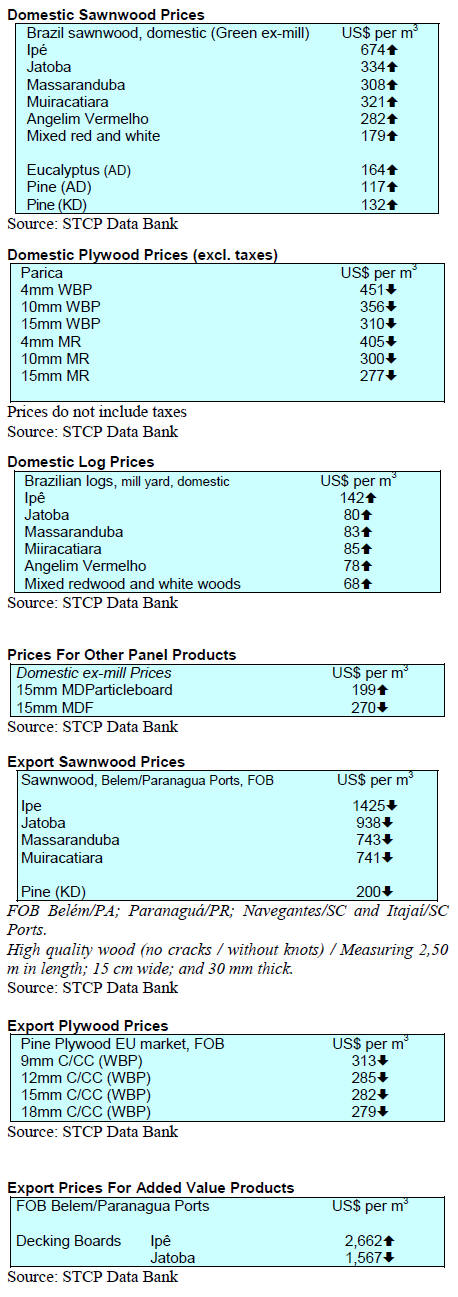
¡¡
8. PERU
Peru¡¯s timber exports concentrated in
three markets
According to a report from the Association of Exporters
(ADEX) 75% of Peru¡¯s 2015 exports of wood products go
to three destinations: China, Mexico and the US. This
concentration is due to several factors, such as trade
agreements, market size and ease of access. These three
markets say ADEX are primarily interested in raw
materials rather than finished products and in the US such
products benefit from lower tariffs.
The head of the commercial intelligence unit in ADEX,
Marcel Ramirez, has said that despite having a wide range
of species available the current export trade pattern does
not encourage investment in downstream manufacturing.
The Chairman of Wood and Wood Industry division in
ADEX, Erik Fischer, has said there are many direct and
indirect barriers holding back production and export of
finished products.
One of the major concerns in international markets is the
issue of legality verification and in the respect Fisher said
that a robust legality verification scheme is required and
that this should be a joint effort between the government
and private sector. He commented that the recent
proposals from SERFOR (Servicio Nacional Forestal y de
Fauna Silvestre) should be discussed further in
cooperation with the private sector.
Road map for the forestry sector
According to Peru¡¯s Ministry of Labour and Employment
(PETM) enhancing the competitiveness of timber forest
sector depends on investment in raising productivity
through training and new technologies. PETM along with
the Center for Technological Innovation in Wood Products
(CITEmadera) recently met to outline such a roadmap.
The aim of the roadmap is to support coordination and
joint efforts by the private enterprise and SERFOR and has
four key elements; forest management, plantations,
Primary transformation and secondary processing.
Astrid Sanchez Falero, Director General of Vocational
Training and Job Training (PETM) said this initiative is an
important step for the forestry sector and she welcomes the
commitment of the private sector in the development of
the roadmap.
Community exports of certified timber
A press release from SERIFOR reports that six indigenous
native communities in Ucayali have just exported certified
wood products to the US. The communities involved are
in Caller¨ªa, Roya, Junin Pablo, Buenos Aires, New Loreto
and Pueblo Nuevo and they secured FSC forest
certification.
For more see: http://www.serfor.gob.pe/noticias/realizanprimera-
exportacion-de-madera-certificada-procedente-debosques-
de-comunidades-nativas-de-ucayali/
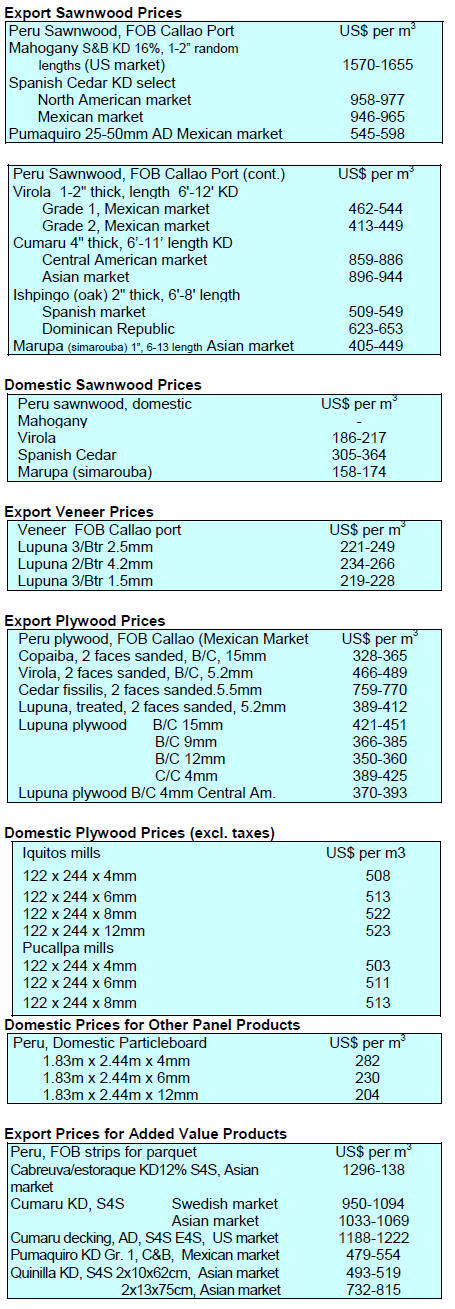 NA
NA
